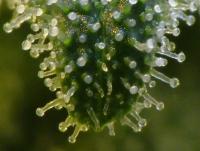

Hashish (more commonly called hash) is a potent form of cannabis produced by collecting and processing the most potent material that female marijuana plants naturally generate as part of their growth cycle.
Trichomes are fine outgrowths or appendages on plants that produce a sticky resin. It is not certain, but the sticky resin is thought to be exuded by plants in order to trap insects that would normally feed on the plant.
In addition to being sticky, the trichomes of the female marijuana plant are a rich source of THC (the primary chemical that causes intoxication when marijuana, hashish, or hash oil are ingested). Hashish is primarily a collection of trichomes that are found on the female marijuana plant.
Marijuana, a cheaper and less potent cannabis product, is the dried flower tops from female cannabis plants. Hashish is obtained by eliminating plant material and collecting the trichomes from the flower tops of female cannabis plants.
After being collected, the trichomes are then usually pressed into a cohesive mass known as hashish. Pressing hashish is simply forcing the collected trichomes together, under pressure.
Besides trichomes, marijuana includes other plant material like leaves, stems, seeds, etc. These other materials are low in psychoactive compounds. Hashish concentrates the THC and eliminates most plant matter found in the cannabis plant. Therefore, hashish is usually more potent than marijuana.
Hash

Trichomes
